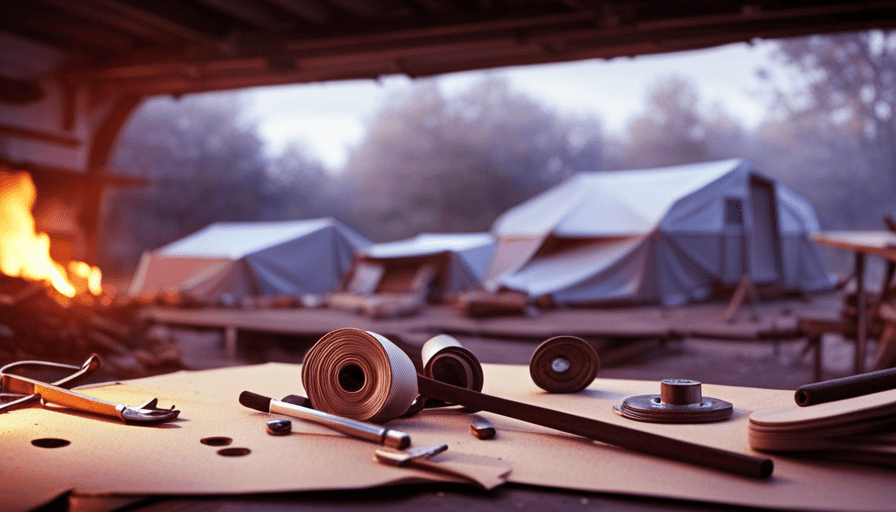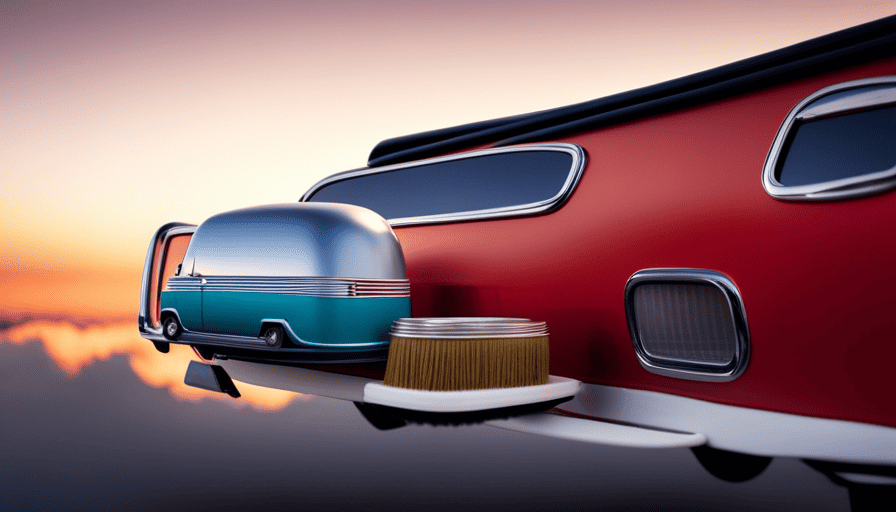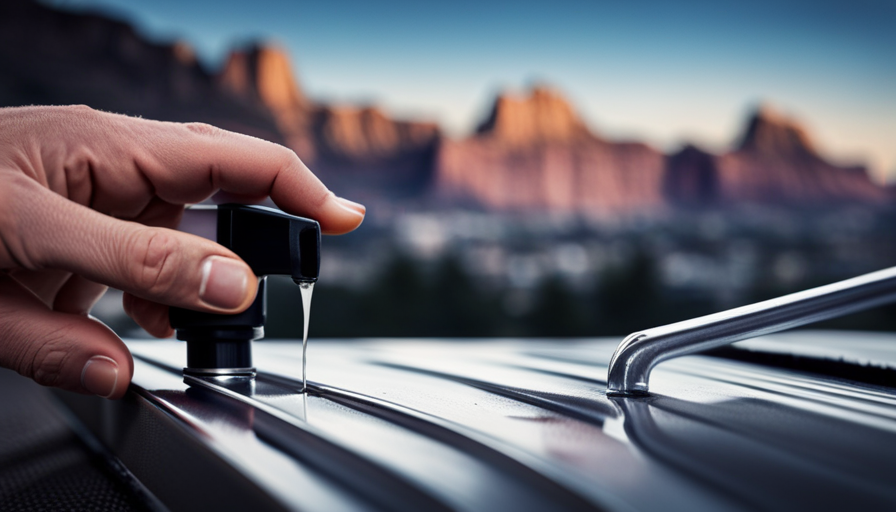Embarking on a camping adventure is like embarking on a quest to uncover hidden treasures. The thrill of exploring unfamiliar lands, marveling at the beauty of nature, and creating lasting memories is a one-of-a-kind experience that cannot be replicated.
But what happens when your trusty camper’s roof starts to show signs of wear and tear? It’s time to consider replacing it. But before you dive into the process headfirst, you’re probably wondering, ‘How much does it cost to replace a camper roof?’
Well, fear not, fellow wanderer, for I am here to shed light on this very question. In this article, we will discuss the different types of camper roofs, the factors that affect the cost, and the average cost range you can expect. We’ll also explore the pros and cons of DIY versus professional installation, additional costs to consider, and tips for finding a reliable roofing contractor.
So, grab your compass and join me on this enlightening journey to uncover the true cost of replacing a camper roof.
Key Takeaways
- The cost of replacing a camper roof can range from $1,500 to $3,000 on average, depending on factors such as size, complexity, and condition of the roof.
- There are different types of camper roofs available, including fiberglass, aluminum, and rubber roofs, each with their own pros and cons.
- DIY installation of a camper roof is possible but requires the necessary tools and equipment, which can add to the overall cost.
- It is important to regularly maintain a camper roof through tasks such as cleaning, inspection, resealing seams, and applying a protective coating to ensure its longevity.
Types of Camper Roofs
You’ll find that there are various types of camper roofs available in the market. When it comes to different camper materials, there are primarily three options: fiberglass, aluminum, and rubber. Each material has its own set of pros and cons.
Fiberglass roofs are known for their durability and resistance to weather elements. They’re lightweight, which makes them fuel-efficient and easy to maneuver. However, they can be more expensive compared to other options, and they may require regular maintenance to prevent cracking.
Aluminum roofs are another popular choice due to their strength and longevity. They’re resistant to rust and corrosion, making them ideal for outdoor use. On the downside, aluminum roofs can be noisy during rainfall, and they may dent upon impact.
Rubber roofs, also known as EPDM roofs, are cost-effective and easy to repair. They provide excellent insulation and are resistant to UV rays. However, they may not be as durable as other materials and can be susceptible to punctures.
Considering the different camper materials and their pros and cons, you can now understand how they affect the cost of replacing a camper roof.
Factors Affecting Cost
When it comes to replacing a camper roof, there are several factors that can affect the cost.
First, the size and complexity of the roof will play a significant role in determining the overall price. Larger roofs or those with intricate designs may require more materials and labor, resulting in a higher cost.
Additionally, the condition of the existing roof is a crucial factor to consider. If the roof is severely damaged or in poor condition, it may require more extensive repairs or a complete replacement, which can drive up the cost.
Finally, the cost of labor and installation will also impact the total price. Highly skilled and experienced professionals may charge more for their services, but their expertise ensures a quality result.
Size and complexity of the roof
The size and complexity of the camper roof can greatly impact the cost, but what factors contribute to its overall price? When considering the cost factors, it is crucial to take into account the roof replacement process. This includes the labor involved, the materials needed, and any additional modifications required. To provide a clearer understanding, I have prepared a table detailing these factors:
| Factors | Description |
|---|---|
| Labor | The number of hours required for the replacement process. |
| Materials | The type and quality of materials used for the new roof. |
| Modifications | Any additional work needed, such as repairing underlying damage or installing new features. |
| Accessibility | The ease or difficulty in accessing the roof for replacement. |
These factors directly influence the cost of replacing a camper roof. However, another significant aspect to consider is the condition of the existing roof. This will be discussed in the subsequent section.
Condition of the existing roof
Your existing camper roof’s condition greatly affects the overall cost of replacement. When evaluating roof damage, it’s important to assess the extent of the issues. Minor damages such as small leaks or cracks can often be repaired without the need for a full roof replacement. This can save you money as the cost of repairs is usually lower than the cost of a complete roof replacement.
However, if the damage is extensive, with multiple leaks, severe rot, or structural issues, replacing the entire roof may be necessary. In such cases, the cost will be higher due to the materials needed and the labor involved in removing the old roof and installing a new one.
Transitioning into the next section on labor and installation costs, it’s important to consider both the condition of your existing roof and the complexity of the replacement process.
Labor and installation costs
To properly install a new roof on your camper, skilled labor is essential, as the process is akin to a delicate dance between the workers and the materials, each move carefully calculated to create a sturdy and watertight structure.
The labor costs for installing a camper roof can vary depending on factors such as the size of the roof, the complexity of the installation process, and the location of the service provider. On average, you can expect to pay between $1,500 and $3,000 for labor and installation. It’s important to note that this cost doesn’t include the price of the materials needed for the roof replacement.
While some individuals may attempt a DIY approach, it’s strongly recommended to hire professionals to ensure a proper installation.
Moving on to the next section about the average cost range…
Average Cost Range
Replacing a camper roof typically costs between $1,500 and $3,000 on average. The actual cost can vary depending on several factors such as the size of the roof, the type of material used, and the complexity of the installation. Average cost camper vans are also influenced by the condition of the existing roof and whether any repairs or reinforcements are needed before the new roof can be installed. Additionally, labor costs for hiring a professional to do the installation can also impact the overall cost. It’s important for owners to carefully consider these factors and get multiple quotes before proceeding with the replacement of their camper roof.
The cost of the camper roof material itself can range from $300 to $1,000, depending on whether you choose a rubber, aluminum, or fiberglass roof. Rubber roofs are often the most affordable option, while aluminum roofs tend to be more expensive but offer excellent durability.
To save on costs, you can consider purchasing the materials yourself rather than relying on the installer to provide them. Additionally, if you have some experience with DIY projects, you might be able to perform the installation yourself, which could save you money on labor costs. However, it’s important to weigh the potential cost savings against the risks involved in doing the job incorrectly.
In the next section, we will discuss the pros and cons of DIY versus professional installation methods.
DIY vs. Professional Installation
When considering whether to go DIY or hire a professional, it’s important to weigh the cost savings against the potential risks involved. DIY installation can be significantly cheaper than hiring a professional. However, it requires a certain level of skill and experience to properly replace a camper roof. If you have the necessary knowledge and tools, DIY can be a viable option.
One of the main advantages of DIY installation is the cost savings. By doing the work yourself, you can save a substantial amount of money on labor costs. Additionally, you have the flexibility to choose the materials and methods that best suit your needs and budget.
However, there are some downsides to DIY installation. It can be time-consuming and physically demanding, especially if you haven’t done this type of project before. There is also a higher risk of making mistakes, which could lead to further damage or the need to hire a professional to fix the issues.
On the other hand, hiring a professional ensures that the installation is done correctly and efficiently. They have the expertise and experience to handle the job with precision. While it may cost more upfront, it can save you from potential headaches and expensive repairs down the line.
The decision between DIY and professional installation comes down to your skills, knowledge, and budget. Consider the pros and cons carefully before making a choice.
When it comes to additional costs to consider, there are a few factors to keep in mind…
Additional Costs to Consider
When considering the cost of replacing a camper roof, it’s important to take into account additional expenses that may arise. While DIY installation may seem like a cost-effective option, there are certain factors that can increase the overall expenditure. For instance, if you lack the necessary tools and equipment, you may need to purchase or rent them, adding to the overall cost. Additionally, if you make any mistakes during the installation process, you may need to hire a professional to fix them, further increasing your expenses.
Furthermore, there are other costs to consider, such as financing options and insurance coverage. Some companies offer financing options that can help spread out the cost of a new camper roof over time, making it more affordable for those on a tight budget. It’s important to research and compare different financing options to find the best fit for your needs.
Insurance coverage is another aspect to consider. Depending on your insurance policy, the cost of replacing a camper roof may be partially or fully covered. It’s advisable to check with your insurance provider to understand the extent of your coverage and any deductibles that may apply.
In the next section, we will explore the various financing options available for replacing a camper roof.
Financing Options
To make the expense more manageable, you can explore different financing options for getting a new roof for your camper. When it comes to financing options, there are several routes you can take to help cover the cost of replacing your camper roof.
Here are some options to consider:
-
Personal loan: Taking out a personal loan can provide you with the funds you need upfront. This option allows you to make fixed monthly payments over a set period, making it easier to budget for the expense.
-
Credit card: If you have a credit card with a high enough limit, you can use it to pay for the roof replacement. Keep in mind that credit card interest rates can be high, so it’s important to have a plan to pay off the balance as quickly as possible.
-
Home equity loan: If you own a home and have equity built up, you may be able to take out a home equity loan to finance the camper roof replacement. This option typically offers lower interest rates compared to credit cards.
-
Insurance coverage: Check with your insurance provider to see if the damage to your camper roof is covered under your policy. If it is, you may be able to file a claim and have the insurance company cover some or all of the cost.
Exploring these financing options can help make replacing your camper roof more affordable. Once you’ve secured the necessary funds, the next step is finding a reliable roofing contractor to do the job.
Finding a Reliable Roofing Contractor
When considering financing options for replacing a camper roof, it’s essential to find a reliable roofing contractor. Finding the right contractor can save you time, money, and ensure a quality roof replacement.
To start, conduct thorough research and read customer reviews to gauge the reputation and reliability of potential contractors. Look for contractors who specialize in camper roofs, as they’ll have the necessary expertise and experience to handle your specific needs.
Cost should also be a factor in your decision-making process. While you want a high-quality roof, it’s important to find a contractor who offers cost-effective roofing options. Request quotes from multiple contractors and compare their prices and services to make an informed decision.
Additionally, consider the contractor’s communication skills and responsiveness. A reliable contractor will be transparent, provide detailed explanations about the roof replacement process, and answer any questions or concerns you may have.
By selecting a reliable roofing contractor who offers cost-effective roofing options, you can ensure a successful camper roof replacement. With the new roof in place, it’s important to maintain it properly to prolong its lifespan.
Maintaining Your New Roof
To ensure the longevity of my new camper roof, I’ve found that there are a few key tips that are essential to follow.
Firstly, regular cleaning and inspection of the roof is crucial in preventing any future damage. This includes removing debris, checking for any signs of wear or tear, and addressing any issues promptly.
Additionally, applying a protective coating or sealant can help to maintain the integrity of the roof and extend its lifespan.
Lastly, implementing preventative measures such as keeping the roof clear of heavy snow or branches can greatly reduce the risk of damage and the need for costly repairs down the line.
Tips for prolonging the lifespan of your camper roof
Extend the life of your camper’s roof by keeping it clean and regularly inspecting for any signs of damage, so you can avoid costly replacements and enjoy worry-free adventures.
When it comes to maintaining your camper roof, there are a few tips that can help prolong its lifespan. Firstly, it’s important to clean the roof regularly, removing any dirt, debris, or moss that can cause damage over time.
Additionally, inspect the roof for any cracks, leaks, or loose seams, as these can lead to water damage and further deterioration. Using the right materials for repairs is crucial, as different materials have their pros and cons.
Lastly, make sure to conduct regular maintenance tasks to prevent future damage, such as resealing seams and applying a protective coating.
By following these tips, you can ensure your camper roof remains in top shape for years to come.
Regular maintenance tasks to prevent future damage
Regularly cleaning and inspecting your camper roof, along with resealing seams and applying a protective coating, keeps it in pristine condition for years to come. By preventing leaks and addressing any issues promptly, you can avoid costly repairs and extend the lifespan of your camper roof. Here are some important maintenance tasks to consider:
-
Roof Cleaning: Remove dirt, debris, and moss regularly to prevent buildup that can trap moisture and cause damage.
-
Inspection: Check for cracks, loose seals, or any signs of wear and tear. Addressing these issues early can prevent leaks and further damage.
-
Resealing and Coating: Regularly reseal seams and apply a protective coating to maintain the roof’s integrity and prevent water infiltration.
Taking these maintenance steps will help ensure your camper roof remains in excellent condition. Next, we will explore insurance coverage options to protect your investment.
Insurance Coverage
Fortunately, insurance can help cover the cost of replacing a camper roof. When filing an insurance claim for roof replacement, it’s important to understand the insurance claim process and coverage limits. Here are four key points to keep in mind:
-
Document the damage: Take detailed photographs and notes of the roof damage before filing the claim. This documentation will help support your case and ensure a smoother claims process.
-
Contact your insurance provider: Notify your insurance company as soon as possible to initiate the claim. Provide them with all the necessary information and documentation to expedite the process.
-
Coverage limits: Review your insurance policy to understand the coverage limits for roof replacement. Some policies may cover the full replacement cost, while others may only cover a portion or have exclusions. Be aware of any deductibles that may apply.
-
Work with a reputable contractor: Your insurance company may have a list of approved contractors or they may require you to obtain multiple estimates. Choose a contractor with experience in camper roof replacements and ensure they’re licensed and insured.
By following these steps, you can navigate the insurance claim process successfully and get the coverage you need for your camper roof replacement.
Now, let’s move on to the section about testimonials and reviews, where you can hear from others who’ve gone through the roof replacement process.
Testimonials and Reviews
When it comes to finding the best roofing professionals for your camper, reading testimonials and reviews from other camper owners can provide valuable insights and guidance.
Their experiences can help you make informed decisions about which professionals are reliable and trustworthy.
By finding reliable reviews and recommendations, you can ensure that you hire the right professionals to replace your camper roof.
Reading and considering other camper owners’ experiences
Surprisingly, many camper owners have shared their jaw-dropping experiences and the astronomical costs of replacing a camper roof. It’s important to consider the experiences of other owners when deciding on the best course of action for your own camper roof replacement.
Here are a few key takeaways from their experiences:
-
Camper roof materials: Some owners found that investing in high-quality materials initially saved them money in the long run. They recommended considering durable options like rubber or fiberglass roofs.
-
Cost-saving tips: Several owners shared cost-saving tips, such as doing the replacement themselves or seeking out affordable roofing professionals who specialize in camper roofs.
-
Regular maintenance: Many owners emphasized the importance of regular roof maintenance to prevent costly repairs or replacements down the line.
Considering these experiences can help you make informed decisions when it comes to replacing your camper roof. Finding reliable reviews and recommendations for roofing professionals is the next step in the process.
Finding reliable reviews and recommendations for roofing professionals
To ensure a successful camper roof replacement, you’ll need reliable reviews and recommendations for roofing professionals who can get the job done efficiently and effectively.
When it comes to finding trustworthy contractors, it’s crucial to do your due diligence. Start by asking fellow camper owners for their experiences and recommendations.
Additionally, online forums and social media groups dedicated to camper enthusiasts can be valuable resources for finding reputable professionals. Make sure to compare prices and quotes from different contractors to ensure you’re getting a fair deal.
Keep in mind that while cost is important, it shouldn’t be the sole determining factor. Look for contractors who have experience specifically with camper roofs and who use high-quality materials.
Reading reviews and testimonials from previous customers can also give you a good idea of a contractor’s reliability and workmanship.
By taking the time to find reliable reviews and recommendations, you can be confident in your choice of roofing professional for your camper roof replacement.
Frequently Asked Questions
How long does a camper roof replacement typically last?
A camper roof replacement typically lasts for several years, but its lifespan can vary depending on several factors. The expected lifespan of a camper roof replacement can be influenced by the quality of materials used, the installation process, and the level of maintenance and care provided.
Factors such as exposure to harsh weather conditions, regular cleaning, and inspections also play a role in determining the durability of a camper roof replacement.
Are there any warranties available for camper roof replacements?
Yes, there are warranties available for camper roof replacements. These warranties vary depending on the manufacturer and the type of roof material used. They typically cover defects in materials and workmanship for a certain period of time.
It’s important to check with the manufacturer or the roofing contractor for specific details and coverage. While the cost of a camper roof replacement can vary depending on factors such as the size of the roof and the type of material used, having a warranty can provide peace of mind and potential cost savings in the long run.
Can I choose a different type of roof material for my camper?
Absolutely! When it comes to camper roofs, you have a wide array of materials to choose from. Each material brings its own set of pros and cons.
For instance, fiberglass roofs are lightweight and durable, but may require more maintenance. On the other hand, rubber roofs offer excellent waterproofing properties, but can be prone to punctures.
Aluminum roofs are extremely durable, but can be heavy. Consider your needs and preferences when selecting the perfect material for your camper roof.
Are there any specific maintenance requirements for a new camper roof?
When it comes to maintenance requirements for a new camper roof, there are a few things to keep in mind. First, regular inspections are crucial to catch any potential issues early on.
Additionally, it’s important to keep the roof clean and free from debris, as this can lead to damage over time.
Lastly, following the manufacturer’s guidelines for maintenance and cleaning is essential.
As for the installation process, it’s best to consult with a professional to ensure it’s done correctly and to avoid any future problems.
What are the signs that indicate I need a camper roof replacement?
Regular roof inspections are crucial for maintaining the longevity of your camper roof. Signs of camper roof damage include water stains on the ceiling, sagging or soft spots, and visible cracks or tears.
One interesting statistic is that 90% of roof leaks are caused by improper maintenance or lack of regular inspections. By conducting regular inspections, you can catch potential issues early on and avoid the costly need for a full camper roof replacement.
Conclusion
In conclusion, replacing a camper roof can be a significant investment, but it’s necessary to ensure the longevity and safety of your vehicle. On average, the cost can range from $1,000 to $5,000, depending on various factors such as the type of roof and whether you choose to hire a professional or do it yourself. When considering the decision to replace your camper roof, it’s important to weigh the potential costs against the benefits of having a secure and durable roof over your vehicle. Additionally, it’s crucial to factor in the average cost of camper van repairs and maintenance over time, as a well-maintained roof can ultimately save you money in the long run. It’s also important to do thorough research and get quotes from reputable professionals to ensure you’re getting the best value for your investment.
One interesting statistic to note is that according to a recent survey, 85% of camper owners reported a decrease in leaks and improved durability after replacing their roof. So, if you’re experiencing roof issues, it’s worth considering a replacement to protect your investment and enjoy worry-free camping adventures.










